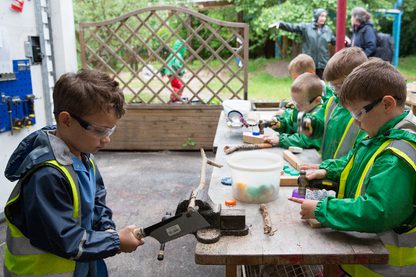Activities and experiences which enable children to develop their curiosity, creativity and problem-solving skills.
For Froebel, inventor of kindergarten, everything linked. His Occupations connected children's first-hand experiences in their local communities with creative materials to communicate and to develop physical and problem-solving skills.
"Froebel devised a series of simple but deeply thought about materials he called ‘gifts’ and ‘occupations’ for use in his kindergartens. The gifts included small crocheted balls on strings for babies and a series of increasingly complex boxed blocks in the shape of a cube, subdivided in different geometric configurations. The occupations included sewing, weaving, paper folding, paper pricking, clay, sticks and peas for construction, parquetry and woodwork. Crucially they were seen as inter-connected parts of a whole approach."
Helen Tovey, Froebel's principles and practice today (2020)
Froebel argued that children learn in the company of knowledgeable and nurturing adults based on their own activity, finding out for themselves and through play.
After he created the first Gifts of the soft balls and the wooden sphere, cylinder and cube, he developed a series of wooden blocks based on different divisions of the cube. Then he began to develop the Occupations.
To learn a thing in life and through doing is much for developing, cultivating and strengthening than to learn it merely through the verbal communication of ideas.

Thinking beyond the solid blocks (Gifts) and linking to the community brought together two strands of Froebel’s thinking in the Occupations. As well as exploring the daily experiences of cooking, gardening and woodwork, children continue to find out about the progression from solid to plane to line to point.
From the solid building blocks, children play with two dimensional shapes as in parquetry or tiles; encounter lines as in sticks, slats and weaving and make points as in paper pricking. Linking points by lines in thread leads to sewing.
Stick and pea constructions lead them to the relationship between point, line and solid. Finally, children return to the most malleable solid - clay.
Each of the Occupations give children the opportunity to develop their curiosity, creativity and problem solving skills. Froebel believed that it was important for children to have access to a wide range of materials and experiences.

"While Froebel’s wooden Gifts can be rearranged or balanced, they cannot be transformed. Transformation, however, is central to the Occupations, which enable children to explore both reversible and irreversible processes."
Prof. Tina Bruce and Jane Dyke, Learning from Froebel (2017)
Introducing some of Froebel's Occupations:

Sewing, threading and weaving
Resources for educators

Clay
Resources for educators

Woodwork
Resources for educators

Cooking
Resources for educators

Paper folding
Resources for educators

Stick and pea
Resources for educators

Tiles and parquetry
Resources for educators

Points and paper pricking
Resources for educators

Sticks, slats and lines
Resources for educators
For a more in-depth understanding of Froebel's Occupations, explore our reading list which includes books and articles on all aspects of Froebelian principles and practice.
You can also read an article about Gifts and Occupations - written by Mark Hunter - on the Froebel Network website.
To have found one quarter of the answers (to his own questions) by his own effort is of more value and importance to the child than to half hear and half understand it in the words of others.


